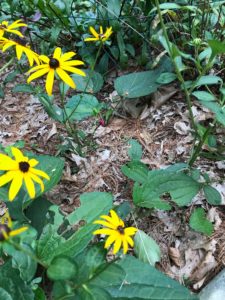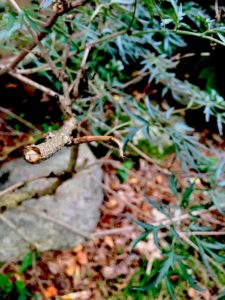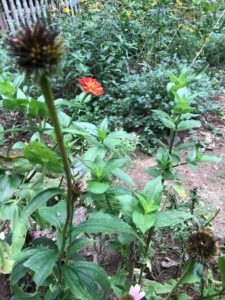Making a Case for Not Cleaning Your Garden in the Fall
By Catherine Carney-Feldman
This article first appeared in MA Master Gardeners Organization October Newsletter and is being reprinted with permission from the author.
Over this past growing season, many of you have observed a drastic decline not only in monarchs but in all butterfly species. Maybe you have also noticed a decline in bees, other beneficial insects, and songbirds as well. As a homeowner or gardener, you might have asked yourself the question, “What can I do to support our declining local wildlife populations?” Besides providing native plants and not using pesticides or herbicides one of the most valuable practices that support pollinators, butterflies, beneficial insects, and small vertebrates is to provide winter cover in the form of fall leaves and standing dead plant material.
For many gardeners, not cleaning or tidying their gardens in the fall, is a hard pill to swallow. The act of cleaning the garden in the fall may be an annual habit, a matter of social and cultural conditioning, or a holdover of outdated gardening practices from yesteryear. For whatever reason, we just can’t seem to keep ourselves from wanting to tidy up the garden at the end of the growing season. Thus, we rake, mow, and blow away every bit of nature that is essential to the survival of moths, butterflies, spiders, and dozens of beneficial arthropods.

Decomposing leaves blend with the environment and act as a mulch, help with water retention, keep weeds down, and add to the fertility of the soil.
Personally, it took me a couple of years to wean myself from this archaic and harmful practice of annual fall cleanup. However, once decided, I’ve never regretted the choice. The only plants and plant materials I now remove from the garden in the fall are diseased. I leave EVERYTHING ELSE! This is the part that at first is hard to get used to. Your gardens do not look immaculate. However, in nature, nothing is immaculate or perfect. By the action of not cleaning our gardens, we are emulating Mother Nature – and she is the best of teachers!
So what is the environmental case for leaving your gardens untouched in the fall? While monarch migration is a well-known phenomenon, it’s not the norm when it comes to butterflies. The vast majority of butterflies and moths overwinter in the landscape in different stages either as eggs, caterpillars, chrysalises, or adults. In all but the warmest climates, these insects, no matter in what stage they hibernate, use the leaf litter for winter cover. Great spangled fritillary, Luna moths, Baltimore checkerspot butterflies, and wooly bear caterpillars tuck themselves into a pile of leaves for protection from cold weather and predators. Red-banded hairstreaks lay their eggs on fallen oak leaves, which become the first food of their caterpillars when they emerge. Luna moths and swallowtail butterflies disguise their cocoons and chrysalis as dried leaves, blending in with the real leaves. These are but a few of countless examples.

Pithy and hollow stems of plants offer a safe winter environment for many native bees, butterflies, and other beneficial insects.
So how do you utilize leaves? When it comes to lawns if you must keep them clear of leaves in the fall and winter, try opting for raking or using a leaf vacuum to capture whole leaves, rather than shredding them with a mower. Shredded leaves will not provide the same cover as whole leaves, and you may be destroying eggs, caterpillars, chrysalises, and other beneficial insects along with the leaves. Instead, collect your leaves and create a leaf pile in the corner of your yard where you can allow them to break down naturally. If you have a compost pile you can add leaves to it. Such efforts will keep insects and other species safe and allow you to benefit from the rich garden gift that falls from the trees above. Better still would be to reduce your overall lawn footprint, replacing it instead with gardens of native plantings that can be the future repositories for fall leaves and habitat that support insects and wildlife.

Decomposing leaves blend with the environment and act as a mulch, help with water retention, keep weeds down, and add to the fertility of the soil.
Leaves in your flower gardens provide many benefits. To mimic the natural ecosystem a layer of leaves needs to be at least two inches thick. Leaves will decompose naturally and as they do they provide valuable organic matter and build up healthy soil. They feed not only earthworms but the many forms of microorganisms that live in the soil. Fallen leaves have the same weed suppression and moisture retention properties of shredded wood mulch – and they are free! In the past, gardeners may have worried that fall leaves, matted down by snow or rain, would have a negative impact on their perennials. In reality, a thick layer of leaves provides additional insulation against bitter cold weather and can protect newly planted perennials when frost-heave may expose tender roots. Anyone who has spotted fragile spring ephemerals popping up in the woods knows that all but the frailest of plants will burst through the leaf litter in spring without trouble. A trick I use in the spring is to brush the remaining leaves under and around my newly emerging plants and perennials. Within two to four weeks, the plant’s new growth hides the remaining leaves. Because of last year’s leaves, I now have my mulch, water retention, weed suppression, and compost all set in my gardens for the upcoming growing season!
The bottom line: You have provided your insects with flowers, bushes, and trees for food, fuel, shelter, and a place to nest. You planted native plant species and avoided pesticides, herbicides, and insecticides. Don’t carry all of that hard work out to the curb or to the landfill. Simply put, when we treat leaves and old plant debris like trash, we are tossing out the beautiful moths, butterflies, pollinators, and insects that we’ll surely miss and when we worked so hard to attract them. The idea is to leave the leaves and other garden vegetative matter for all the benefits mentioned above. If you still decide you need to clean up the garden and remove the leaves in the spring, make sure you wait until late in the spring season, around mid-May, until hibernating insects have had a chance to emerge so as not to destroy all the life you’ve so worked to protect! Or you can, choose like me to “leave the leaves”!
About the Author
Catherine Carney-Feldman is a member of the Ipswich Conservation Commission, a Senior Principal Master Gardener, owner of Shamrock Acres Environmental Landscape and Design, and Board Member of the Ipswich Humane Group. As a volunteer, Catherine oversees and maintains the nature gardens at the Ipswich River Wildlife Sanctuary, the largest Audubon property in MA. She lives in Ipswich with her husband David and many rescued animals including three horses, four dogs, ten chickens, three ducks, and one rooster named Copernicus.

